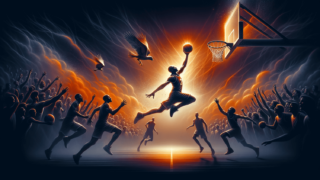
Influence of Basketball on Sports Science and Injury Prevention
Written by: Basketball Universe
Last updated:

Blending the pace of riveting competition with the energy of gravity-defying athleticism, basketball has long held an enviable position in the world of sports. Yet behind the thrills and excitement lies a significant and often overlooked impact: the influence of basketball on sports science and injury prevention. Join us as we journey through the fascinating intersection of pioneering research, state-of-the-art methodologies, and the relentless pursuit of excellence on the hardwood floor. Prepare to be drawn into the intricate connection between this beloved pastime and the field of sports science, where we’re learning to keep our athletes healthier, stronger, and ready for the game!
Influence of Basketball on Sports Science and Injury Prevention
Basketball has significantly contributed to the development of sports science and injury prevention by demanding innovative approaches to optimize player performance and safety. The high-intensity and fast-pace nature of the game have prompted advancements, such as biomechanical analysis, load monitoring, and recovery techniques, to reduce injury risks and enhance athlete longevity. Additionally, basketball’s impact in injury prevention has driven the creation of injury prevention programs, focusing on strength training, conditioning, and functional movement, which can be tailored to the specific needs of basketball players and are now being applied across various sports.
Jump-Starting Performance: The Development of Load Monitoring
Load monitoring in basketball has evolved exponentially since the sport’s inception. By tracking players’ workload and its impact on their bodies, coaches and trainers are now better able to identify the right balance between training and rest, ensuring players can perform at their peak without overexerting themselves. Let’s dive into the role of load monitoring in basketball and the innovations it has spurred.
Technology Takes Center Court: Wearables and Tracking Systems
The emergence of wearable technology and tracking systems has revolutionized load monitoring in basketball. Using accelerometers, GPS, and optical-tracking cameras, these technologies capture real-time data on player movement, providing instant feedback on load and performance. By integrating this data with sports science, coaches can tailor training regimens to optimize player recovery and minimize injury risk, making an important positive impact on the game. These innovations in wearable technology not only benefit basketball but have also been embraced by numerous other sports.
Flying High: Biomechanical Analysis and Injury Prevention
Basketball history has seen some incredible advances in skills and stunts, but an athlete’s feats come at a cost. To help players maintain optimum health and avoid injuries, biomechanics experts have entered the fray. Through in-depth biomechanical analysis, experts can better understand movement patterns and identify areas of potential injury risk.
The Science of Slam Dunks and Layups
Biomechanical analysis provides a unique perspective on players’ formations and motions, looking specifically at how they jump, land, accelerate, and decelerate. By analyzing the forces and torques placed on various joints during gameplay, specialists can pinpoint the exact points of stress and strain that may lead to injury. These insights then inform the development of injury prevention programs tailored to each player’s needs, improving stability, flexibility, and overall movement efficiency.
The Revolution of Recovery Methods
As the intensity and workload of basketball players continue to rise, so does the importance of effective recovery. Pushing the boundaries of sports science, experts have explored various recovery methods to maximize player performance and minimize downtime from fatigue or injury. Let’s take a closer look at some of the essential recovery techniques for basketball players today.
Cryotherapy: The Chill Factor
Cryotherapy, or cold therapy, is gaining popularity in basketball circles as a means to reduce inflammation and promote recovery. Players immerse themselves in cryotherapy chambers or liquid nitrogen-cooled chambers, which can reach temperatures as low as -130°C (-202°F) for short periods—typically just a few minutes. Although more research is needed to confirm long-term effectiveness, many athletes swear by cryotherapy’s rejuvenating effects after grueling practices and games.
Compression Garments: The Squeeze Strategy
Compression garments, like sleeves or tights, apply constant pressure to the wearer’s muscles and increase blood flow. This helps reduce muscle fatigue and soreness, especially after high-intensity workouts and games. While studies have shown mixed results, anecdotal evidence from athletes suggests that compression garments play a role in expediting recovery for basketball players and other high-performance athletes.
Customizing Injury Prevention Programs
Injury prevention is paramount in basketball, where the risk of injury is high due to the sport’s explosive movements, quick direction changes, and high-impact landings. Sports science and injury prevention specialists have developed various programs to help mitigate these risks, working closely with athletes and coaches to introduce targeted exercises and routines.
Strength and Conditioning: The Power Boost
A strong and resilient body is less likely to sustain injuries. Therefore, basketball injury prevention programs often include dedicated strength and conditioning exercises. By focusing on core stability, coordination, and balance, the athletes build the foundation necessary to withstand rigorous gameplay. Furthermore, sport-specific strength training enhances athletes’ performance, allowing them to jump higher, sprint faster, and maneuver more effectively on the court.
Functional Movement Screening (FMS): The Motion Magnifier
By assessing players’ movement patterns, the FMS detects potential weaknesses that may lead to injury, such as muscle imbalances, poor mobility, or limited flexibility. Trained professionals use a scoring system to evaluate players’ performance during a series of functional movement tests. Based on these scores, personalized corrective strategies are developed to improve athletes’ movement patterns and reduce the risk of injury.
Applying Basketball’s Lessons to Other Sports
The advancements in sports science and injury prevention pioneered by basketball have had a ripple effect, extending benefits to other sports as well. The biofeedback data, recovery methods, injury prevention exercise routines, and technology developed to support basketball players now serve as invaluable resources to help all athletes optimize their physical capacities, minimize injuries, and enjoy longer, healthier careers.
Conclusion
The influence of basketball on sports science and injury prevention has been formidable, offering a wealth of insights and techniques to support not only the players who grace the courts but athletes of all disciplines. As technology and research continue to advance, we can look forward to even more innovations that will enhance the sports world’s understanding of optimizing athletic performance while safeguarding athletes’ health and well-being.
Embracing Psychological Well-being and Mental Health
While physical health is paramount in basketball, the influence of sports science on basketball has also led to increased awareness of the importance of athletes’ mental health and well-being. Maintaining a positive state of mind has a significant impact on player performance, and teams are increasingly investing in psychology professionals to support their athletes.
Mindfulness Techniques: The Inner Game
Mindfulness-based mental training is growing in importance among basketball players and coaches as a way to improve focus, reduce stress, and maintain peak performance. Techniques like meditation, visualization, and breathing exercises help athletes stay present and perform better under pressure. Moreover, fostering a culture of mental wellness ultimately benefits the entire team dynamic.
The Rise of Player Empowerment: Focus on Nutrition and Lifestyle
In addition to advancements in injury prevention and sports science, basketball has played a significant role in emphasizing the importance of proper nutrition and lifestyle choices both on and off the court. The effectiveness of any sports science recommendation is closely tied to an athlete’s overall well-being, and basketball has set the stage for incorporating holistic health practices into professional sports.
Nutrition: Fueling Performance
Today’s basketball athletes are increasingly aware of the impact of nutrition on performance and injury prevention. Balanced, personalized diets that cater to an individual’s specific nutritional requirements have become essential elements of a player’s daily routine. Players are encouraged to consume meals rich in protein, complex carbohydrates, healthy fats, and essential vitamins and minerals, all while staying well-hydrated. The shift in focus on nutrition within basketball has influenced other sports to acknowledge its importance in supporting physical performance and recovery.
Lifestyle Choices: Off-the-Court Impact
How an athlete conducts their life away from the sport is as important as their on-court performance when it comes to injury prevention and career longevity. Proper sleep, stress management, and maintaining a healthy personal life are all essential factors in ensuring an athlete’s overall well-being. Basketball’s progressive approach to taking care of its players has inspired other sports to focus on the importance of off-the-court factors in maintaining athletes’ health and optimal performance.
Advancements in Protective Gear and Equipment
Another aspect of basketball’s influence on sports science and injury prevention is the ongoing research and innovation in the design of protective gear and equipment. As a fast-paced contact sport, basketball players benefit from constantly evolving developments in protective wear, playing surfaces, and game accessories that improve safety.
Cushioning the Impact: The Evolution of Footwear
Basketball shoes have come a long way since their early days, representing an essential part of injury prevention in the sport. Modern footwear design focuses on providing proper cushioning, superior fit, and stability for athletes. Advances in shoe design have not only benefited basketball players but have also inspired improvements in other sports where footwear plays a crucial role in preventing injury.
Game Changers: Basketball Court Surfaces
As research into sports injuries deepens, one aspect that has emerged as a key area of interest is the impact of playing surfaces on injury risk. Basketball courts have been the testing ground for innovations in sports flooring. Shock-absorbing surfaces, lighter and more resilient materials, and moisture-resistant finishes all contribute to creating safer and more comfortable playing environments for athletes. These groundbreaking findings have had a considerable influence on sports science in general and the way other sports approach their facilities and playing surfaces.
FAQ: Sports Science and Injury Prevention in Basketball
Delving deeper into the world of basketball’s influence on sports science and injury prevention, check out this comprehensive FAQ section. Here, we address some common questions related to this topic, providing concise and informative answers for a better understanding.
1. How has basketball contributed to the development of load monitoring?
With the advent of wearable technology and tracking systems, basketball’s intense and fast-paced gameplay demanded innovations in the collection and analysis of real-time player movement data. By integrating this data with sports science and uniquely tailoring training regimens, load monitoring has played a significant role in optimizing player recovery and minimizing injury risk in basketball.
2. What are some examples of technology used for load monitoring in basketball?
Examples of technology used for load monitoring in basketball include accelerometers, GPS devices, and optical-tracking cameras. These technologies capture real-time data on player movement and workload, assisting coaches and trainers in making data-driven decisions for training and recovery.
3. How does biomechanical analysis help in injury prevention for basketball players?
Biomechanical analysis seeks to understand the forces and torques acting on an athlete’s joints during gameplay. By studying their movement patterns and identifying areas of potential injury risk, specialists can develop tailored injury prevention programs that focus on improving stability, flexibility, and overall movement efficiency for the athlete.
4. What are some popular recovery methods used by basketball players?
Some popular recovery methods used by basketball players include cryotherapy, compression garments, massage, and hydrotherapy. These techniques help reduce inflammation, increase blood flow, and expedite the recovery process after intense workouts and games.
5. What do strength and conditioning exercises in basketball injury prevention programs typically target?
Strength and conditioning exercises in basketball injury prevention programs typically target core stability, coordination, balance, and sport-specific strength. These exercises focus on building a strong and resilient body to withstand rigorous gameplay and reduce the risk of injuries.
6. How do functional movement screenings (FMS) contribute to injury prevention?
FMS assess players’ movement patterns to detect potential weaknesses, such as muscle imbalances or poor mobility, that may lead to injury. Based on the evaluation, personalized corrective strategies are developed to improve athletes’ movement patterns and reduce the risk of injury.
7. How has basketball influenced nutrition and lifestyle choices among athletes?
Basketball has emphasized the importance of proper nutrition and lifestyle choices as essential aspects of an athlete’s overall well-being. Balanced, personalized diets and healthy habits, such as maintaining proper sleep and stress management, have become integral components of basketball players’ daily routines.
8. How has basketball impacted the development of protective gear and equipment?
Basketball has fostered advancements in protective gear and equipment, with ongoing research focusing on improving player safety. Innovations in shock-absorbing surfaces, footwear design, and protective wear have emerged from the sport’s unique requirements, benefiting not only basketball players but also athletes from various other sports.
9. What role does mental health play in sports science and injury prevention in basketball?
Maintaining a positive state of mind is crucial for optimal performance and injury prevention in basketball. Teams are investing in psychology professionals to support their athletes, utilizing techniques such as mindfulness training to improve focus, reduce stress, and help players perform better under pressure.
10. How have basketball’s advancements in sports science and injury prevention benefited other sports?
Through pioneering research in biomechanics, load monitoring, innovative technology, recovery techniques, mental health, and nutrition, basketball has driven the development of sports science and injury prevention practices that have extended benefits across various sports, improving athletic performance and well-being across the board.
Featured Posts
- No pillar pages found.





